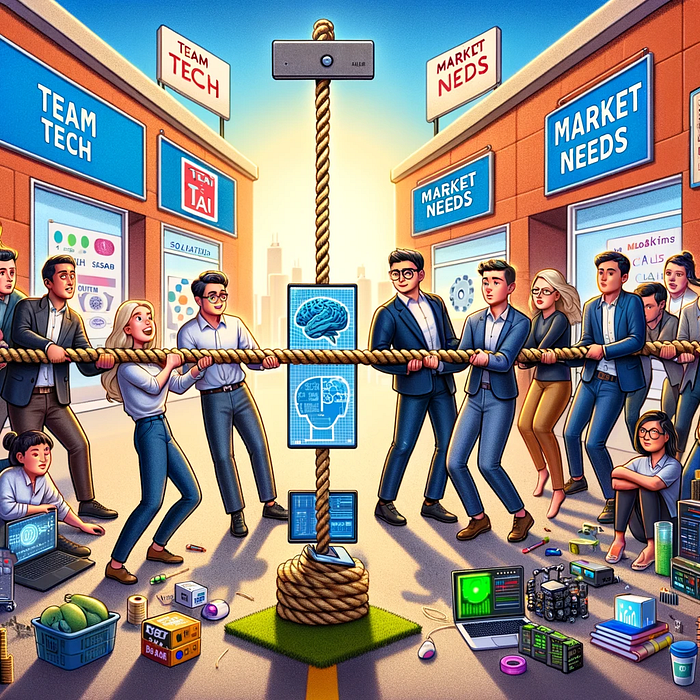Imagine a bright-eyed entrepreneur (that's me) with dreams bigger than a data center, eagerly diving into the exciting world of AI startups.
The goal? To ride the AI wave straight to success. However, reality is like a wild roller coaster ride through a place I call Daisyland. Unfortunately, it's a common reality that less than 10% of startups make it on average.
Different projects come with their own risks. Many of my failed startups were linked to data analytics and included elements of what we call AI.
I want to share the hard lessons I've learned while creating, testing, and trying to make my products successful in the market. So, apply these insights to your data-focused startup, potentially boosting your win rate!
1. Falling for the AI Siren Song… and Missing R & D
And I built it—a shiny high-tech solution looking for a problem.
Picture an advanced solution capable of predicting what you want for breakfast before your first yawn.
Great, right? But here's the kicker: In the rush to wow the world, I forgot to check if anyone wanted what I was cooking.

I once worked on a system to monitor the status of 10kV overhead power lines, using data from vibrations and magnetic fields. Our goal was to understand the market, identify the issues that line operators were facing, and create the perfect signal decoder for those sensors.
We accurately identified the problem, but our research and development (R & D) moved too slowly to meet market demand. Eventually, a wireless solution from China outperformed what we had done in our specific area. If we had adopted their technology earlier, we could have been the top choice in the market. :)
Solving complex problems doesn't automatically create a good business. Decide whether you are creating something new with your own R & D, which could lead to breakthroughs like very accurate predictions for supply chains. This is a profound challenge, technology-based.
Or, you could work to fix specific problems for fast-moving consumer goods (FMCG) companies, making their purchasing process better and faster, which is more about understanding business needs. The first way is to make technology help solve business problems.
The second way is to understand what the business problems are and then choose the best existing technology to solve them. Trying to do both with a small team and limited resources often leads to confusion, financial issues, and loss of motivation.
2. Technology vs. Market Pull
It turns out that launching an AI startup is not just about creating technological masterpieces. It's like being a matchmaker between the needs of Mr. Revolutionary Tech and Mrs. Market.
I learned (the hard way) that you have to start by working up the market, understanding its quirks, and then, perhaps, introducing your AI to solve real headaches. But I was there, trying to fit my precious AI solution into the round hole of market needs. Spoiler: It doesn't work that way.

For tech founders, it's a hard realization that early stages like POC or MVP often don't require advanced tools like Data Science, LLM, or the latest Python libraries. Instead, it's important to simulate your future complex data service and manually replicate its operations.
Yes, that's the basic work.
Diving into AI/DS development too early, before properly validating the problem and solution, leads to wasted time, depleted resources, and potentially the collapse of your startup.
You might end up with a technically perfect project that doesn't actually meet customer needs. Initially, you should focus on creating something basic but functional—like a mobile app or web interface—to attract users.
Right from the start, tasks like merging, forecasting, and recommending should be done manually before moving on to more sophisticated methods like neural networks and OpenAI APIs. This approach is not about scalability but about proving the value of your concept.
Once proven, you can confidently leverage advanced technology to enhance your solution.
3. The Data Movie
Then comes the data movie. Imagine having a supercar but no fuel. That's me with my AI model—all dressed up with nowhere to go because, unfortunately, I skimmed over the data.
Quality data is the hero of AI; it's what makes your AI model go from so-so to wow. But did I realize that in time? Of course not. The takeaway: Data is not just another item on the checklist; it's the secret sauce.

When starting to build, it's essential to have a clear understanding of the problem and access to a wide range of relevant data. High-quality, up-to-date data is key to developing accurate models.
A note for non-tech founders: Don't expect miracles from your CTO or co-founder if you only provide them with a small dataset like a 120-row Excel file from a client. In data science and AI, a large amount of data is often necessary, sometimes even millions of data points. You might consider setting up a pilot project to gather quality data, especially if you're creating a B2B SaaS product. Getting the right data is as important as involving key decision-makers in the process.
For example, I was part of starting an application designed to cut data center energy consumption by up to 20% by predicting server workload. However, the challenge was finding real workload data.
We quickly created a shell script to generate semi-random CPU/RAM usage patterns of varying lengths using the application’s stress tool and scheduled it. Surprisingly, we began accurately predicting the next 15 minutes of workload on our test server within weeks. I even bought a 1U HP server for home experiments despite the loud noise.
Six months later, we landed our first potential customer—a major data center operator—and installed our monitoring tool on various types of servers. But then came the disappointment. Real-world workload data changes in seconds, not minutes or hours, and there were much smaller fluctuations than expected. Our prediction system couldn't adjust, learn, or predict accurately.
The lesson is clear: Next time, we start with data.
4. Finding the Right Balance
Starting our startup journey is super exciting, but there's a trick to keeping it smooth.
Right from the get-go, we have to be sharp about our choices. It's like choosing the best tools that don't cost an arm and a leg but still grow with our big dreams. And when it's time to let the world in on our great ideas, let's be sneaky about it.
Share enough to spark interest but keep the magic secret to protect it.

When you start your journey with an AI startup, it seems like hiring expensive experts and building very complex technology right away. But think twice before opening your wallet.
In the early days, it's smarter and cheaper to use simple, well-known methods. This means doing everything simply without wasting money and ensuring you're addressing the problems that need solving. Jumping into preferred technology like AI guessing what you want before you hear it sounds cool, but it's crucial to ask if you're ready for it and if people need it.
Sharing your big ideas can be risky, especially with larger companies that might execute your idea themselves and do it. Also, relying too much on external technology can be an issue if it turns out to be too expensive or doesn't work the way you need it to.
You have to be careful about who you share your creative ideas with and ensure you're making smart choices about the technology you use. This way, you maintain control over your innovations and ensure they stay yours.
The Takeaway: A Little Humor, A Ton of Wisdom
So, dreamers and doers, that's the story of how I surfed, stumbled, and learned in the AI startup tale.
It's a journey of mistakes, faces, and ultimately, wisdom. Remember, the road to startup stardom is not just about technological glitz; it's about romancing the market, waltzing with data, and riding the trend waves with a sharp eye on where it's heading. So, be prepared, be agile, and perhaps, just maybe, you'll crack the code to a successful startup in the world of AI.
Join me in the world of data, startups, and my personal journey! Click here.
Follow me for exclusive insights, stories, and lessons along the way. Let's explore the progress of innovation together.
